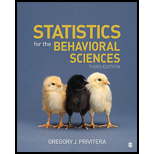
Concept explainers
1.
Complete the F table.
Make the decision to retain or reject the null hypothesis.
1.
Answer to Problem 23CAP
The complete F table is,
| Source of Variation | SS | df | MS | |
| Between groups | 24 | 2 | 12 | 4.80 |
| Between persons | 33 | 11 | 3 | |
| Within groups (error) | 55 | 22 | 2.5 | |
| Total | 112 | 35 |
The decision is rejecting the null hypothesis.
Explanation of Solution
Calculation:
From the given data, the between groups mean squares is 12, the between persons mean squares is 3, sum of squares within groups is 55. There are three groups and the sample size is 12.
Degrees of freedom for between groups:
The formula is given by,
Substitute 3 for k.
Thus, the value of degrees of freedom for between groups is 2.
Degrees of freedom for between persons:
The formula is given by,
Substitute 12 for n,
Thus, the degrees of freedom for between persons is 11.
Degrees of freedom for within groups:
The formula is given by,
Thus, the degrees of freedom for within groups is 22.
Total Degrees of freedom:
The formula is given by,
Thus, the total degrees of freedom is 35.
The sum of squares between groups is,
Where,
Substitute
Thus, the sum of squares between groups is 24.
The sum of squares between persons is,
Where,
Substitute
Thus, the sum of squares between persons is 33.
The total sum of squares is,
Where,
Substitute
Thus, the total sum of squares is 112.
Mean square Error:
Where,
Substitute
F statistic:
The ANOVA table is,
| Source of Variation | SS | df | MS | |
| Between groups | 24 | 2 | 12 | 4.80 |
| Between persons | 33 | 11 | 3 | |
| Within groups (error) | 55 | 22 | 2.5 | |
| Total | 112 | 35 |
The data gives that the test statistic value is
Decision rule:
- If the test statistic value is greater than the critical value, then reject the null hypothesis or else retain the null hypothesis.
Critical value:
The given significance level is
The numerator degrees of freedom is 2, the denominator degrees of freedom as 11 and the alpha level is 0.05.
From the Appendix C: Table C.3 the F Distribution:
- Locate the value 2 in the numerator degrees of freedom row.
- Locate the value 11 in the denominator degrees of freedom column.
- Locate the 0.05 in level of significance.
- The intersecting value that corresponds to the numerator degrees of freedom 2, the denominator degrees of freedom 11 with level of significance 0.05 is 3.98.
Thus, the critical value for the numerator degrees of freedom 2, the denominator degrees of freedom 11 with level of significance 0.05 is 3.98.
Conclusion:
The value of test statistic is 4.48.
The critical value is 3.98.
The value of test statistic is greater than the critical value.
The test statistic value falls under critical region.
By the decision rule, the conclusion is rejecting the null hypothesis.
2.
Find the effect size using partial omega-squared
2.
Answer to Problem 23CAP
The effect size for the test by using
Explanation of Solution
Calculation:
The given ANOVA suggests that the value of
Partial Omega-Squared:
The formula is given by,
Where
Substitute 24 for
Hence, the effect size for the test by using
Want to see more full solutions like this?
Chapter 13 Solutions
Statistics for the Behavioral Sciences
 Glencoe Algebra 1, Student Edition, 9780079039897...AlgebraISBN:9780079039897Author:CarterPublisher:McGraw Hill
Glencoe Algebra 1, Student Edition, 9780079039897...AlgebraISBN:9780079039897Author:CarterPublisher:McGraw Hill Holt Mcdougal Larson Pre-algebra: Student Edition...AlgebraISBN:9780547587776Author:HOLT MCDOUGALPublisher:HOLT MCDOUGAL
Holt Mcdougal Larson Pre-algebra: Student Edition...AlgebraISBN:9780547587776Author:HOLT MCDOUGALPublisher:HOLT MCDOUGAL

